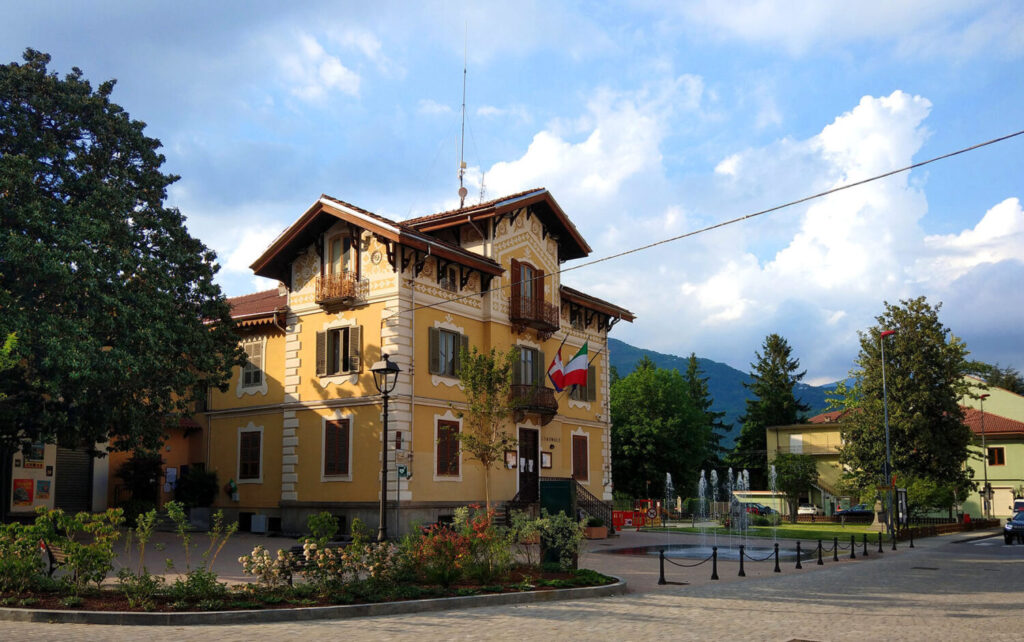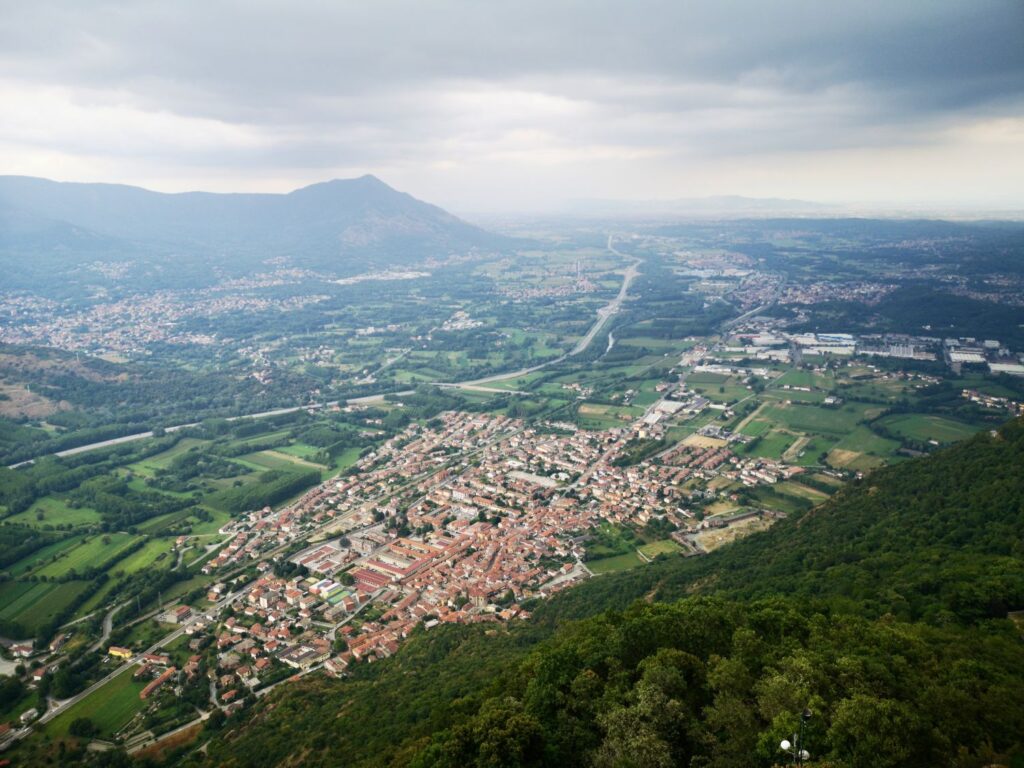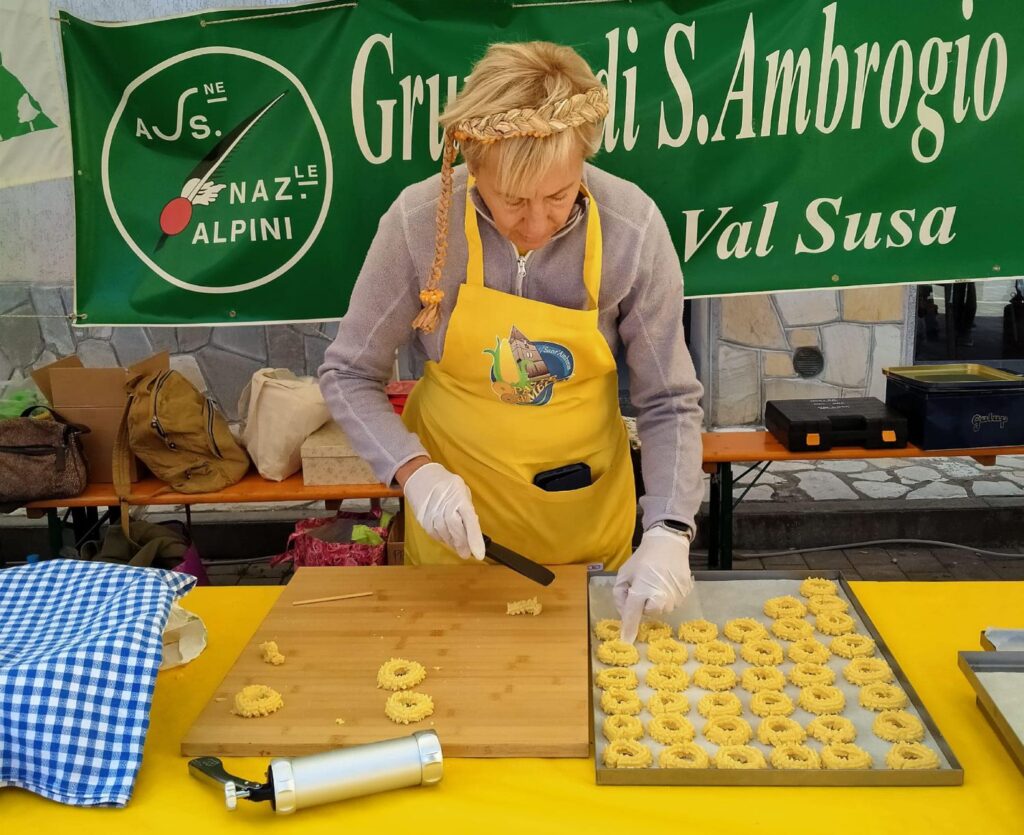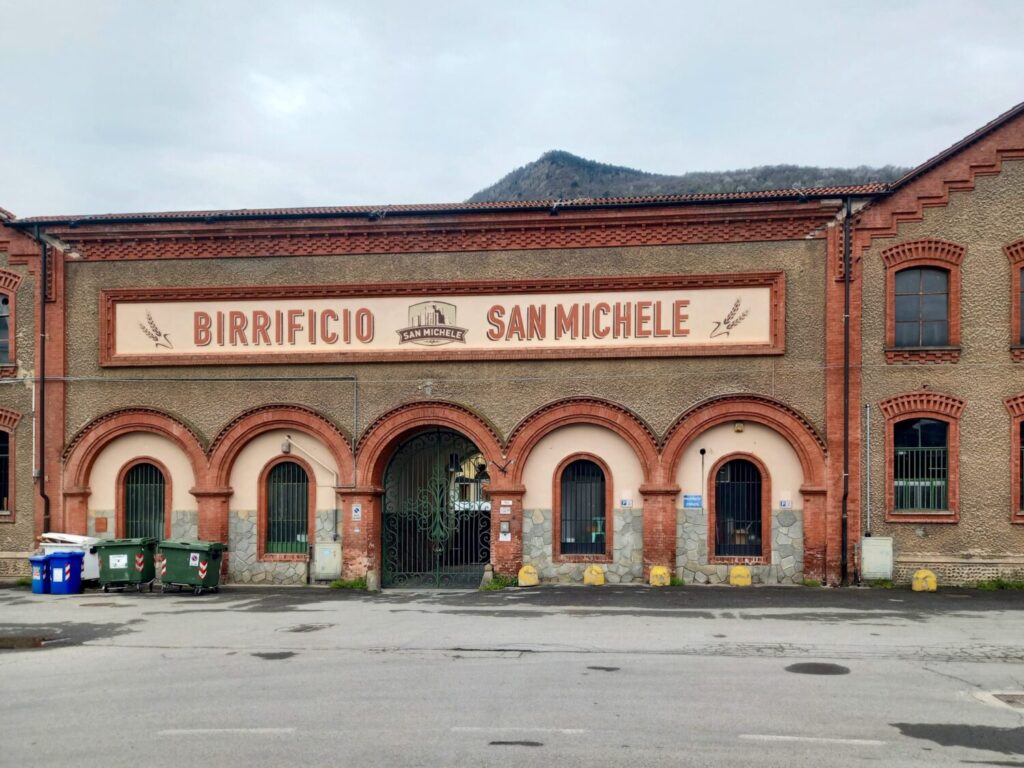Sant’Ambrogio di Torino is a charming medieval village nestled in the Susa Valley, just 30 kilometres from Turin. I know it well, as it is the place where I grew up, even though I now happily live in the city. Famous for its proximity to the Sacra di San Michele, the iconic abbey that has become a symbol of Piedmont, the village is worth visiting for its narrow cobbled streets, historic landmarks, and echoes of an almost-forgotten industrial past.
As you wander through the centre, history feels alive. You can almost picture medieval pilgrims walking along the Via Francigena on their way to Rome, their footsteps resonating through the same alleys and stone pavements that still shape the village today.
Table of Contents
Why Visit Sant’Ambrogio di Torino
A visit to Sant’Ambrogio di Torino offers the chance to discover an authentic village, far from the usual tourist routes, where history, art, spirituality, and good food intertwine. Its location at the foot of the Sacra di San Michele and along the ancient Via Francigena makes it an ideal stop for those who love medieval towns and cultural journeys.
PLAN YOUR TRIP TO ITALY
Stay connected on the go with a Holafly eSIM, offering unlimited data at reliable 3G, 4G, and LTE speeds across Italy.
For added peace of mind during your travels, take out Heymondo travel insurance, perfect for a stress-free and well-protected adventure.
If you plan to explore beyond the main cities, renting a car is the best way to discover Italy’s hidden gems at your own pace.
Whether you are looking for a day trip surrounded by nature or a destination steeped in history and tradition, Sant’Ambrogio welcomes you with a warm, homely atmosphere and plenty of inspiration for curious travellers.
The Historic Centre of Sant’Ambrogio di Torino
The heart of Sant’Ambrogio still preserves its medieval layout, with narrow cobbled lanes, stone houses, and picturesque corners at every turn. Among the most remarkable landmarks is the Church of San Giovanni Vincenzo (St John the Baptist), built in the 11th century. Inside, it holds ancient frescoes and valuable architectural details that reflect its long history.
The church itself is striking in size and presence, accompanied by a 37-metre Romanesque bell tower that dominates the skyline. While the church is usually open to visitors, the bell tower is open only on special occasions.
The village’s true symbol, however, is the Clock Tower, overlooking the central square. Built in the 13th century as part of the defensive walls, some of which are still visible today, it has been a landmark for locals for centuries. Restored in the 1990s, the tower now houses the town’s public library, open during scheduled hours. Walking through this square, you can feel history under your feet and the timeless charm of a village that has carefully preserved its identity.

The Abbots’ Castle of Sant’Ambrogio
Just behind the Parish Church of San Giovanni Vincenzo, at the start of the mule track leading up to the Sacra di San Michele, stands the Abbots’ Castle. Built in the Middle Ages, its goal was to welcome and protect pilgrims travelling along the Via Francigena. Rebuilt several times from the year 1000 onwards, it served both as the residence of the abbot and as the centre of secular power in the area.
In the 18th century, the Castle was reduced to ruins by the French general Catinat and remained abandoned for centuries. Thanks to recent restoration projects, supported by both public and private funding, part of the complex has been brought back to life and opened as a public space, allowing visitors to reconnect with its thousand-year history. Unfortunately, the accommodation facilities once housed within the Castle are now permanently closed.
The Industrial Heritage of Sant’Ambrogio di Torino
Beyond its medieval and religious past, Sant’Ambrogio di Torino also boasts a fascinating industrial heritage, telling the story of a village that successfully combined tradition, labour, and innovation. Among its most notable enterprises were the historic Cotonificio Valle di Susa, once a symbol of industrial Piedmont, and later the world-famous Imperia pasta machines, still recognised across the globe today.
The Cotonificio Valle di Susa
The textile mill was built at the end of the 19th century along the Meana canal, which powered its machinery. In 1880, Emilio Wild and Augusto Abegg, descendants of wealthy Swiss families, founded the company Wild & Abegg. It later became known as the Cotonificio Valle di Susa, gradually expanding its factories until it operated sites throughout the province of Turin, employing around 5,000 workers.
During the Second World War, a bomb damaged the plant, but it was quickly restored. Between 1949 and 1953, most of the buildings were demolished, leaving only one villa that still stands today as a silent witness to this extraordinary industrial past.
The Bosio Knitwear Factory
Another key player in Sant’Ambrogio’s industrial growth was the Maglificio Bosio, founded in 1871 by brothers Pietro and Augusto Bosio along the Cantarana canal, whose waters powered the machinery. The factory employed around 700 workers by 1889 and reached 1,000 by 1910.
The owners’ villa, built in 1875, was later converted into the Town Hall. Part of the former factory buildings today houses the Birrificio San Michele, a craft brewery. This transformation is a remarkable example of how industrial heritage can find new life in contemporary projects, preserving both memory and identity within the village.
From the Village to the Sacra di San Michele: Trails and Views
One of the main reasons to stop in Sant’Ambrogio is its privileged location at the foot of the Sacra di San Michele. This monastery has become a symbol of the Piedmont region. From here, several hiking trails wind their way up through woodland and spectacular viewpoints over the Susa Valley, reaching the abbey complex in about an hour and a half. Walking these paths means immersing yourself in both nature and history, experiencing a journey that blends effort, beauty, and spirituality.
The Via Francigena and Its Spiritual Legacy
Sant’Ambrogio di Torino lies along the historic Via Francigena, the ancient pilgrimage route that once connected Canterbury to Rome. As you stroll through the village, you can follow stretches of this historic path and imagine medieval pilgrims making their way towards the Eternal City.
This profound spiritual connection gives the village an atmosphere suspended in time, comprising quiet corners, evocative views, and tangible history, which links the medieval town to the trail leading up to the Sacra.
The Ancient Mule Track: Pilgrims and Tradition
From Piazza IV Novembre, next to the Parish Church of San Giovanni Vincenzo, begins the ancient mule track climbing up to the Sacra di San Michele. Used for more than a thousand years by pilgrims, travellers, and mountaineers, the path has fifteen granite cross stations, erected in 1943 as an invocation of peace.
Even today, the mule track is a place of devotion during the week in honour of Our Lady of Fatima, when the statue of the Virgin from the hamlet of San Pietro is carried in procession up to the sanctuary. For the local community, this is both a spiritual retreat and a cherished tradition. For visitors, it remains one of the most authentic experiences in Sant’Ambrogio, where history, faith, and breathtaking landscapes intertwine.

Traditions and Gastronomy in Sant’Ambrogio di Torino
Alongside history and nature, Sant’Ambrogio di Torino welcomes visitors with the authentic flavours of Piedmontese cuisine, where every dish reflects local traditions and the surrounding landscape. Among the regional specialities are agnolotti filled with meat or vegetables, the iconic bagna cauda dipping sauce made with garlic and anchovies, and handmade desserts typical of the valley, such as the much-loved paste di meliga corn biscuits.
The village comes especially alive during the feast of St John the Baptist, its patron saint, and during events like Meliga Day, when the streets fill with food stalls and market stands selling local produce. Strolling through the narrow lanes of the historic centre, you’ll be tempted by the aromas and flavours of the region, discovering dishes lovingly prepared according to traditional recipes.
Events and Festivals in Sant’Ambrogio di Torino: Traditions, Food and Historical Re-enactments
Sant’Ambrogio di Torino comes alive throughout the year with events that weave together culture, food, and history, transforming the medieval village into a vibrant stage of centuries-old traditions. Local festivities are the perfect opportunity to discover Piedmontese dishes, artisanal sweets, and regional products. At the same time, stalls and performances animate the cobbled streets.
Religious celebrations, historical re-enactments, and food festivals, such as the San Giovanni Battista (St John the Baptist) celebration or Meliga Day, allow visitors to experience village life through folklore, music, and convivial moments. Wandering through Sant’Ambrogio during these events, you can sense the community’s deep connection to its past, while enjoying the timeless charm of its medieval setting.
St John the Baptist Celebration
The patron saint’s celebration, held every November, is one of the most eagerly awaited events in Sant’Ambrogio. Blending religious tradition, historical re-enactment, and lively conviviality, it offers visitors an immersive and authentic experience.
One of the most distinctive highlights is the symbolic figure of the Abbà, who rides on horseback through the streets of the village, offering refreshments to the locals. Marching bands, craft stalls, and plenty of typical Piedmontese food accompany the celebrations.
Joining this festival means stepping into the daily life and experiencing the living traditions of Sant’Ambrogio, where you can taste local dishes and immerse yourself in an atmosphere where medieval history meets a vibrant modern community.
Meliga Day
Every September, Sant’Ambrogio celebrates Meliga Day, an annual event dedicated to paste di meliga. These traditional Piedmontese cornmeal biscuits have become a symbol of the village’s culinary identity.
During the festival, the streets of the historic centre fill with food stalls, local produce, artisan crafts, children’s workshops, and live music, turning the village into a true feast of flavours. Visitors can taste freshly baked paste di meliga, uncover the story behind this much-loved dessert, and enjoy the aromas, colours, and community spirit that make this event so special.

The Battle of the Chiuse and Medieval Re-enactments
On the last Saturday of June, Sant’Ambrogio di Torino transforms into a living medieval village to commemorate the Battle of the Chiuse, the legendary clash of 773 between Charlemagne’s Frankish army and the Lombard troops of King Desiderius.
Throughout the evening, the streets come alive with music, dancing, medieval games, fire shows, jugglers, and concerts of ancient music. Restaurants serve menus inspired by Lombard traditions, with dishes prepared according to age-old recipes.
A unique feature of the event is the Balengu, a commemorative coin minted especially for the occasion. Visitors can exchange it at the gates of the village and use it to purchase food and crafts at the festival stalls.
Children in particular love the interactive activities: historical games, archery practice, and medieval workshops designed for families. My own son adores this event, and spending the entire day here has always been an unforgettable experience for younger visitors.
The festival culminates with a spectacular open-air theatre performance re-enacting the historic battle on the church square, offering an immersive journey into history that truly captivates the whole family.

Practical Information for Visiting Sant’Ambrogio di Torino
You can explore the historic centre of Sant’Ambrogio in just a couple of hours, but if you plan to hike up to the Sacra di San Michele, allow at least half a day.
The Abbey can be reached on foot via scenic hiking trails or by car, with parking available at the base of the complex. A shuttle service operates from the railway station of the nearby town of Avigliana to make the ascent easier. For more details on routes, curiosities, and visiting tips, read my complete guide to the Sacra di San Michele.
If you are travelling with children, a simple and enjoyable option is the cycle path between Sant’Ambrogio di Torino and the neighbouring village of Chiusa San Michele. This flat, safe route is perfect for a family outing. Not only does it allow you to admire the beauty of the Susa Valley in peace, but it also offers a relaxing alternative to the uphill trek to the Sacra, combining nature, light exercise, and fun for both adults and kids.

How to Get to Sant’Ambrogio di Torino
Reaching Sant’Ambrogio is easy both by car and by train. By car, the village lies along the SS25 Moncenisio road, the same route that leads to Mont-Cenis Lake. For a faster, though less scenic option, you can take the A32 Turin–Bardonecchia motorway and exit at Avigliana Est.
From Turin, the drive takes around 40–45 minutes. I recommend using Google Maps to find the most convenient route. Several free car parks are available near the historic centre and at the trailheads leading to the Sacra di San Michele, while parking in front of the Town Hall is limited by a parking disc system. On public holidays or during special events, parking spaces can fill quickly, so it’s best to arrive early.
If you prefer travelling by train, Sant’Ambrogio is on the Turin–Bardonecchia railway line. Regular connections from both Porta Nuova and Porta Susa stations in Turin will get you to the village in about 40 minutes, without the hassle of traffic or parking.
Where to Eat in Sant’Ambrogio di Torino
Among the village’s taverns and eateries, Osteria dal Merlo is a favourite stop for a traditional Piedmontese lunch. Housed in a 19th-century building just steps away from the Town Hall Square and the Parish Church of San Giovanni Vincenzo, it serves local classics such as agnolotti, vitello tonnato, tongue in green sauce, and homemade desserts, all paired with regional wines. The warm and rustic atmosphere makes every meal here feel like a journey into the village’s history. During festivals and special events, the osteria also offers themed menus and more elaborate dishes, such as bagna cauda.
For a completely different experience, Birrificio San Michele offers the lively feel of a brewery with a standard pub-style menu. What makes it truly special is its location inside the former Cotonificio Valle di Susa, a striking example of industrial architecture transformed for modern use. By booking a guided tour, you can learn about the brewing process firsthand, making it not only a tasty stop, but also an educational and engaging visit for both adults and children.

Where to Stay in Sant’Ambrogio di Torino
The village of Sant’Ambrogio itself does not have hotels, but you can find accommodation in the surrounding area. One of the most atmospheric options is Certosa 1515, a former Carthusian monastery in the hamlet of Mortera, Avigliana. It has been transformed into a guesthouse with a restaurant serving traditional Piedmontese cuisine.
Staying here allows you to experience the Susa Valley at a slower pace, surrounded by history and nature, while still being just a few minutes’ drive from both the village and the Sacra di San Michele. Its location makes it ideal for combining cultural visits with outdoor activities such as hiking or cycling along the flat path that links Sant’Ambrogio to Chiusa San Michele.
Why Visit Sant’Ambrogio di Torino
Sant’Ambrogio di Torino is a village where history, culture, nature, and culinary traditions come together in the unique setting of the Susa Valley. Wandering through its medieval streets, following stretches of the Via Francigena, exploring the Abbots’ Castle, or hiking the ancient mule track up to the Sacra di San Michele, you’ll experience a journey that feels both authentic and atmospheric.
Local festivals such as the St John the Baptist celebration, Meliga Day, and the medieval re-enactments of the Battle of the Chiuse add a lively touch of folklore, offering the chance to enjoy food, music, and activities, especially fun for families with children.
Whether you are planning a day trip or a longer stay in the surrounding area, Sant’Ambrogio welcomes you with the warmth of a small village that has preserved its identity through centuries of change. Between past and present, tradition and innovation, it remains one of Piedmont’s hidden gems, ready to surprise you with history, flavours, and unforgettable views.
